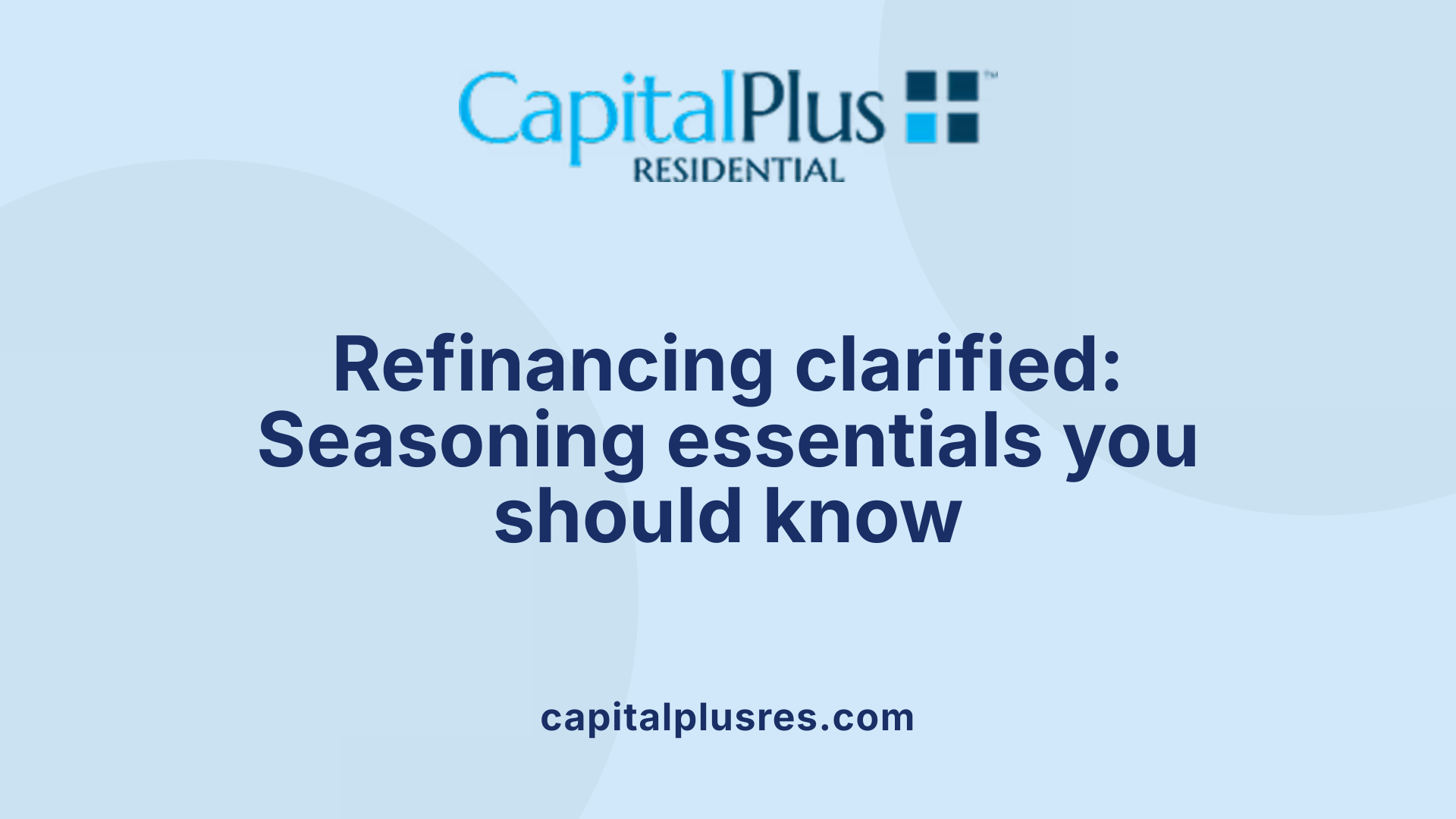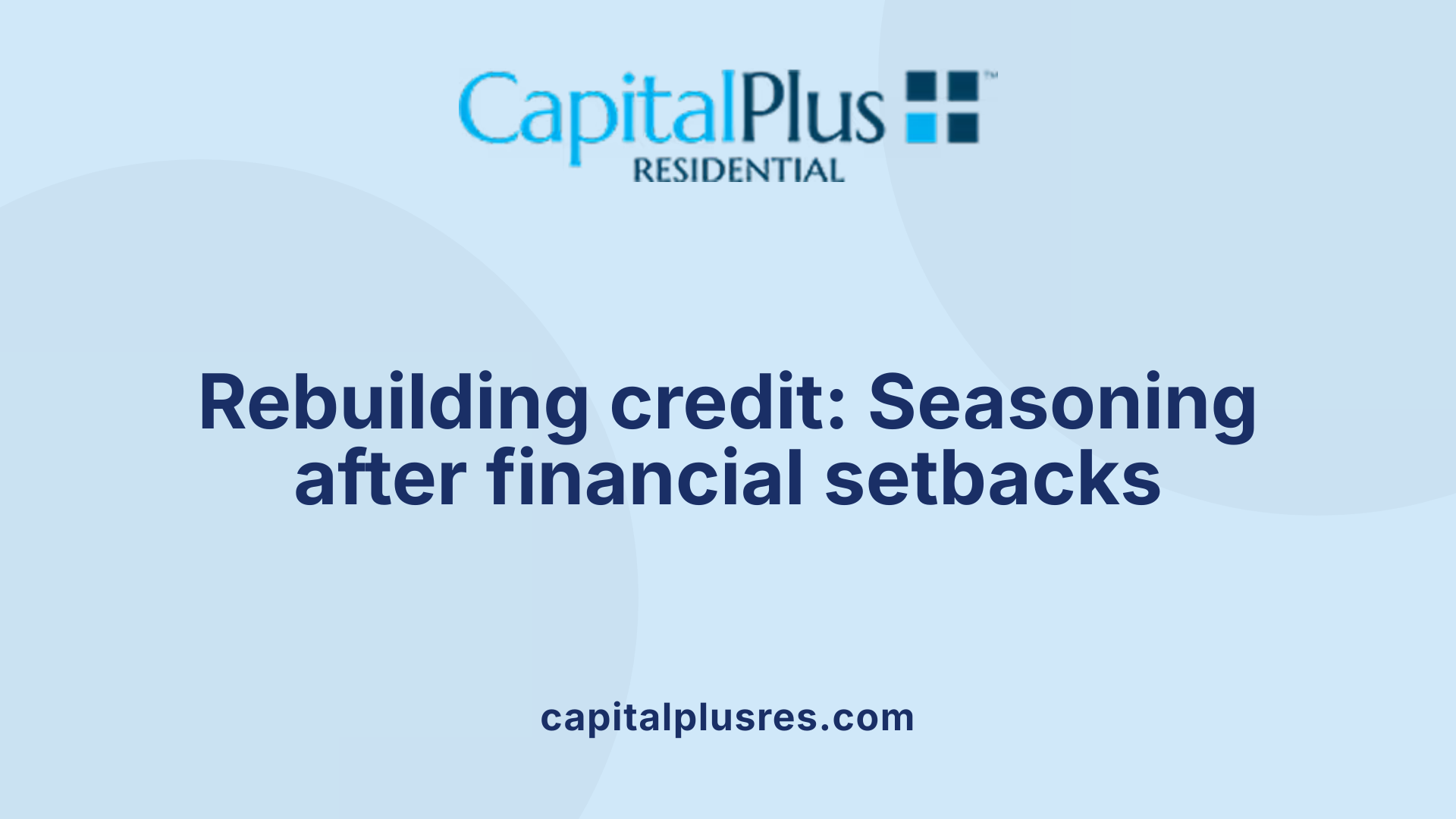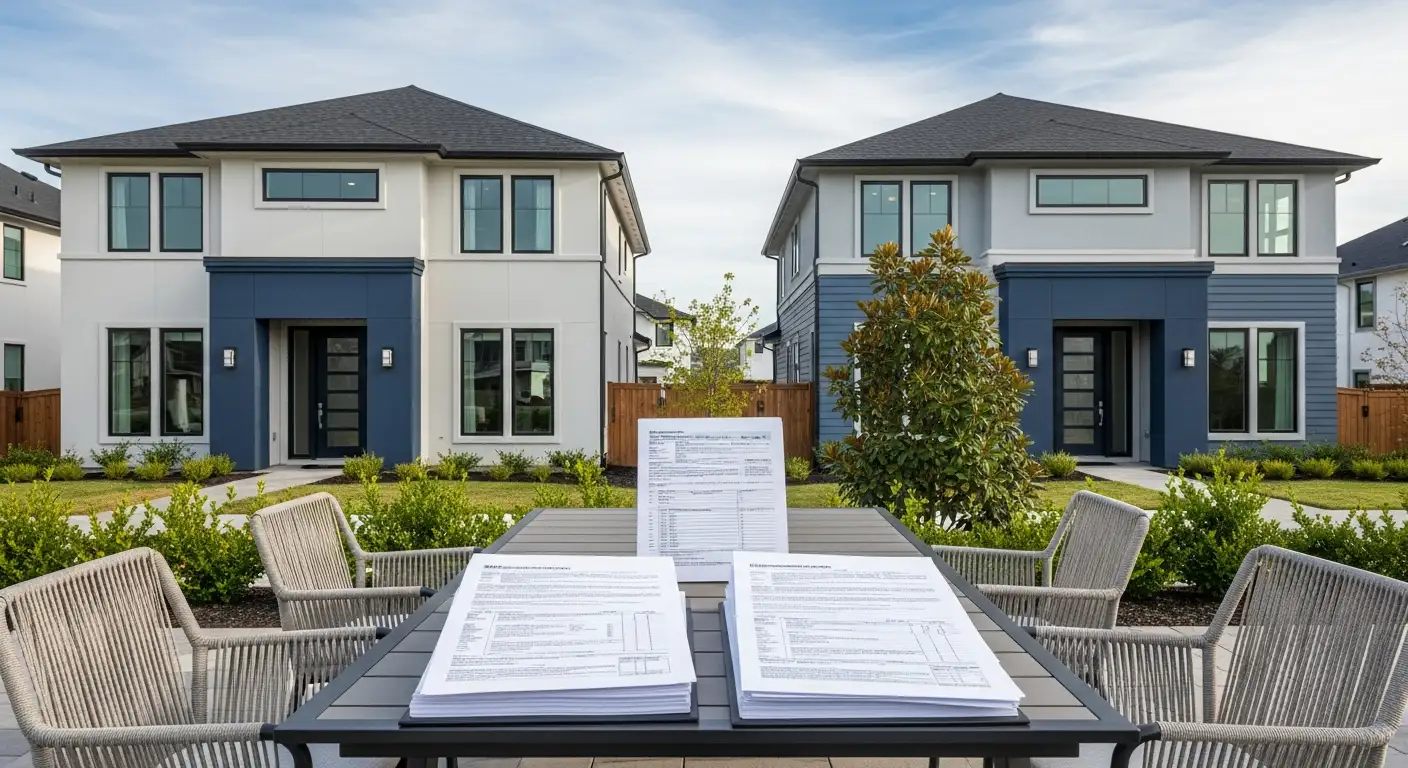Introduction to Mortgage Seasoning and Its Role in Refinancing
Mortgage seasoning is a crucial but often misunderstood requirement in the home financing process, particularly when it comes to refinancing existing loans. This article explains what mortgage seasoning means, why it matters, and how it impacts borrowers looking to refinance. We’ll also explore related seasoning rules for down payments, adverse credit events, and cash-out refinance transactions, while providing essential context about mortgage brokerage and residential lending services. Understanding these factors is vital for navigating the real estate market effectively and securing the best mortgage options available.
Mortgage Brokerage Services and Their Role in Securing Financing

What are mortgage brokerage services?
Mortgage brokerage services act as an independent bridge connecting homebuyers with a diverse set of lenders. Brokers guide clients through the mortgage process by collecting necessary documents, assisting with preapprovals, completing loan applications, and clarifying legal disclosures. They research multiple lenders, comparing their offerings to secure better loan rates and terms tailored to the borrower's financial profile. Many brokers provide these comprehensive services at no direct cost to the borrower, leveraging their broad lender connections to access exclusive deals that may not be available through direct bank channels.
How do mortgage brokers help homebuyers secure financing?
Mortgage brokers evaluate a borrower’s financial health—including credit reports, income, and expenses—to identify suitable mortgage options. They tap into a vast network that includes conventional, unconventional, and non-qualified mortgage (Non-QM) lenders. By comparing offers, brokers often find competitive interest rates and favorable terms not readily accessible to consumers. They also handle much of the paperwork and verification processes, streamlining approvals and easing the borrower's workload. While brokers are generally compensated by lenders, borrowers should select licensed and reputable brokers to ensure objective advice and the best financing arrangements.
What are the benefits of using mortgage brokerage services instead of going directly to a bank?
Using a mortgage broker offers broader access to multiple lenders and a wider variety of loan products, making it easier to compare interest rates and loan conditions than working with a single bank. Brokers provide personalized guidance through complex loan requirements, which benefits borrowers with special financial or credit circumstances. Some lenders operate exclusively through brokers, offering more diverse and flexible financing solutions. Although banks may provide perks like discounts for existing customers, brokers frequently negotiate better terms and tailor mortgage products more closely to borrower needs, ultimately simplifying the process and increasing the chance of securing optimal loan agreements.
Overview of Residential Lending Services

What are residential lending services?
Residential lending services encompass a broad spectrum of financial activities aimed at helping individuals secure loans for purchasing, refinancing, or constructing homes. These services are typically provided by licensed mortgage lenders and loan servicers, who must comply with regulations such as the California Residential Mortgage Lending Act (CRMLA).
Licensing and regulatory compliance
Mortgage lenders must obtain proper licensing under state and federal laws to operate legally. This licensing ensures consumer protection by mandating transparency and fair practices. Borrowers can verify the status of a lender's license and report complaints through regulatory resources, which help maintain trust and accountability in the mortgage industry.
Loan origination and servicing
The process starts with loan origination, where lenders evaluate borrower eligibility and structure mortgage terms. Once a loan is issued, servicers manage the ongoing loan aspects, including payment processing, escrow accounts for taxes and insurance, and customer service. This lifecycle management is essential to maintain loan performance and borrower satisfaction.
Role in facilitating homeownership
By effectively connecting borrowers to appropriate financing options, residential lending services play a critical role in making homeownership accessible. They provide vital capital and support throughout the mortgage process, enabling buyers to navigate complex financial requirements within a regulated and secure framework.
Types of Residential Mortgage Loans and Factors Influencing Loan Choice

What types of residential mortgage loans are typically offered through lending services?
Residential mortgage loans commonly available include conventional fixed-rate mortgages, adjustable-rate mortgages (ARMs), and government-backed options such as FHA, VA, and USDA loans. Conventional loans often require higher credit scores and larger down payments but may offer lower overall costs. Government-backed loans provide more flexible qualification criteria, making them accessible for a wider range of borrowers. Jumbo loans cater to high-priced properties that exceed conforming loan limits and require stronger credit and larger down payments.
Each loan type has distinct features related to interest rates, down payment needs, and eligibility, so the choice depends on the borrower's credit profile, property value, and long-term plans. For instance, borrowers anticipating short-term ownership may choose adjustable-rate mortgages for lower initial rates, while those seeking long-term stability often prefer fixed-rate loans.
What factors do lenders consider when approving residential mortgage loans?
Lenders assess borrower credit score, income, assets, and employment history to evaluate financial stability and repayment ability. They apply the 28/36 rule to ensure housing expenses and total monthly debts stay within accepted limits. Verifying income and employment with documentation is standard.
The property itself is also scrutinized through appraisals and title checks to ensure its value and ownership status meet loan requirements. Loan-to-value ratios and overall debt-to-income ratios quantify risk factors, while credit history reveals reliability in meeting prior obligations.
Lenders may also consider the property type and specific demands of government loan programs. This thorough review helps ensure loans are granted to borrowers who can responsibly manage payments, reducing the risk of default.
| Loan Type | Key Features | Borrower Suitability |
|---|---|---|
| Conventional Fixed | Stable interest rate, higher credit requirements | Long-term owners with good credit |
| Adjustable Rate (ARM) | Lower initial rates, variable over time | Borrowers planning short-term ownership |
| Government-Backed | Flexible qualifications, lower down payments | Those needing easier approval or lower credit scores |
| Jumbo Loans | For high-value homes, strict credit criteria | Buyers of expensive properties |
Understanding these types and lender criteria helps borrowers choose suitable loans aligning with their financial situation and homeownership goals.
Understanding Mortgage Seasoning: Definition and Purpose

What is mortgage seasoning?
Mortgage seasoning refers to the amount of time that funds must be held in a bank account before they can be used toward a down payment or closing costs—usually between 60 and 90 days. This concept isn't limited only to funds; it also covers the period that must pass since taking out a mortgage or experiencing major credit events, such as bankruptcy or foreclosure, before a borrower can qualify for a new loan.
Why do lenders require seasoning?
Lenders use mortgage seasoning to verify that the funds used in a home purchase or refinance are legitimate and not obtained through illegal means. Seasoning also helps demonstrate the borrower’s financial stability and reliability, which are crucial for assessing credit risk. By requiring seasoning, lenders can better ensure that borrowers are well-positioned to meet their mortgage obligations over the long term.
Different contexts of seasoning
Mortgage seasoning applies across various scenarios beyond funds for down payments. For instance, refinancing a mortgage typically requires that the original loan be seasoned for at least six months. Similarly, after adverse credit events, such as bankruptcy or foreclosure, waiting periods of several years are expected before a new mortgage can be approved. Different loan types—such as conventional, FHA, or VA loans—may have varying seasoning timelines and rules. Some funds, like bonuses and tax refunds, may be exempt from seasoning requirements, while large deposits often require documented proof of legitimacy.
Seasoning Requirements for Refinancing Explained

What Are Seasoning Requirements for Refinancing?
Refinancing a mortgage typically involves a seasoning period, which is the minimum amount of time that must pass after the original loan closing before you can refinance. Most lenders require a six-month waiting period after the initial mortgage disbursement before approving a refinance. This trend ensures the borrower’s stability and reduces fraud risk.
Longer Waiting Periods After Foreclosure or Short Sale
For properties that have undergone a foreclosure or short sale, seasoning requirements to refinance may extend beyond the usual six months. Foreclosure seasoning typically lasts around four years, while certain short sales might lead to longer waits, depending on the lender’s rules and loan type. This extended period helps assess the borrower's financial recovery.
Exceptions and Types of Refinancing
Not all refinancing follows the same seasoning rules. Limited cash-out refinancing, which involves paying off existing loans like mortgages, construction loans, or installment land contracts, has specific eligibility requirements. For instance, at least one borrower must have owned the property for a set time, liens paid off must be purchase-related or energy improvements, and the property must not be relisted for sale before the refinance closes.
These specialized refinances may also allow cash back up to 1% or $2,000 with documentation supporting the refund reasons. Some exceptions exist for recently purchased homes under a "delayed financing" rule, allowing refinancing within six months if no mortgage was initially used.
Overall, seasoning requirements protect lenders and borrowers, ensuring refinancing happens under financially sound conditions, while different refinance types have tailored rules to accommodate diverse situations.
Down Payment Seasoning and Documentation Requirements

What Are Down Payment Seasoning Requirements?
For mortgage lenders, funds used toward a down payment generally must be in a bank account for a minimum of 60 days before they can be applied to a home purchase. This seasoning period helps lenders verify that the money is legitimate and stable, reducing risks of fraud or last-minute, questionable deposits.
Duration Funds Must Be Seasoned in Bank Accounts
The typical seasoning period ranges between 60 to 90 days. During this time, the money should not move rapidly or appear as a large unexplained deposit. This time frame gives lenders assurance that the borrower has steady access to the funds and that they have not been recently borrowed or acquired in ways lenders consider risky.
Types of Funds Requiring Seasoning
Most cash held in a bank account requires seasoning, especially large deposits or funds transferred in from other sources. However, some exceptions apply:
- Bonuses from an employer
- Tax refunds
- Gifted funds (depending on the lender's rules)
These types of funds typically do not need to be seasoned before they can be used for the down payment.
Documentation for Verification
Lenders require clear documentation proving the seasoning of funds. This includes:
- Bank statements covering the entire seasoning period
- Proof of any large deposits to ensure they come from legitimate sources
- Additional paperwork if loans or gifts contribute to the down payment
To streamline approval, borrowers are advised to keep funds in one account and maintain transparent records demonstrating the money’s origin and length of time held.
By following these seasoning and documentation guidelines, borrowers improve their chances of a smooth mortgage approval process.
Seasoning After Bankruptcy and Foreclosure: Timelines and Impact on Refinancing

What are bankruptcy and foreclosure seasoning requirements?
After a foreclosure or bankruptcy, borrowers typically face mandatory waiting periods before they can qualify for a new mortgage. These periods help lenders evaluate the borrower's financial recovery and reduce lending risk.
Typical waiting periods for bankruptcy and foreclosure
- Foreclosure: Generally requires a seasoning period of about four years.
- Bankruptcy: Often requires a waiting period that can extend up to seven years.
Exact timelines depend on the type of loan and specific borrower circumstances.
Differences based on loan types and circumstances
- Conventional loans might have longer seasoning requirements.
- Government-backed loans like FHA or VA often have shorter waiting periods but still require mandatory seasoning.
- Some lenders may apply exceptions or reduced waiting periods based on evidence of improved creditworthiness or completion of foreclosure alternatives.
How seasoning affects loan eligibility
Mortgage seasoning after these adverse events is critical to reestablish creditworthiness. Lenders require demonstration of financial stability and responsible credit management during this period before approving new loans or refinancing. Failure to meet seasoning timelines generally results in ineligibility for mortgage refinancing or new loan approvals.
Borrowers planning to refinance or apply for new mortgages after bankruptcy or foreclosure should factor in these seasoning requirements to improve their chances of loan approval and favorable terms.
Limited Cash-Out Refinance Transactions: Conditions and Eligibility

What is a Limited Cash-Out Refinance?
Limited cash-out refinance transactions allow borrowers to obtain a new first mortgage primarily to pay off an existing mortgage, construction loan, or installment land contract. This refinancing option is designed for specific situations where borrowers want to restructure their mortgage without taking significant cash out beyond payoff amounts.
Ownership and Lien Requirements
To qualify, at least one borrower on the new loan must be an owner of the property at the time of application. Exceptions include cases of inheritance, ownership through trusts, or ownership obtained via legal awards. Additionally, the property should not have been relisted for sale after the refinance disbursement, ensuring that the refinancing is for long-term ownership rather than short-term resale.
Only subordinate liens that were used to purchase the property or for energy-related improvements secured by PACE loans can be paid off during this refinance. Any other subordinate liens must remain subordinate and comply with Fannie Mae eligibility guidelines.
Restrictions and Permissible Scenarios
Limited cash-out refinance transactions must refinance an existing first mortgage. If the existing first mortgage is being paid off, it generally must be at least 12 months old unless exceptions such as paying off subordinate liens or buying out co-owners apply.
Acceptable uses of the proceeds include paying off the existing mortgage, financing closing costs, clearing subordinate liens that relate to purchase or energy improvements, and minor cash back—limited to 1% of the new loan amount or $2,000—usually to cover overpaid fees.
Some additional eligibility criteria are applied when loan-to-value (LTV), combined LTV (CLTV), or high combined LTV (HCLTV) ratios exceed 95%, such as requiring the property to be an owner-occupied, one-unit principal residence, and meeting specific underwriting conditions.
Ineligible refinances include those without an existing first lien, transactions using proceeds improperly, or refinancing with prohibited shortcuts like temporary interest rate buydowns or unpaid PACE loans.
By adhering to these conditions, limited cash-out refinance offers borrowers a controlled refinancing option that limits cash withdrawals while facilitating debt management and improving loan terms.
Exemptions and Exceptions to Seasoning Requirements

Are there exceptions to seasoning requirements?
Yes, there are notable exemptions and exceptions to mortgage seasoning requirements designed to accommodate different financial scenarios.
Certain types of funds are exempt from the typical seasoning period. For example, bonuses and tax refunds do not require the funds to be held in a bank account for 60 to 90 days before they can be used for a down payment or closing costs. Additionally, gifted funds generally do not require seasoning, easing the process for borrowers receiving financial help from relatives or friends.
One significant exception is the delayed financing exception. This allows a borrower to purchase a property and then refinance the mortgage within six months, provided specific documented conditions are met. These conditions include ensuring the initial purchase was an arm's-length transaction and that no mortgage financing was used for the acquisition. This exception helps buyers by letting them access cash from the property's equity soon after purchase.
Seasoning requirements also vary depending on the loan type. Government-backed mortgages, such as FHA or VA loans, typically require longer seasoning periods—often between 7 to 12 months—before refinancing can occur. Conventional loans usually have shorter seasoning times, sometimes as brief as 30 days before refinancing is allowed. These variations are essential for borrowers to understand as they navigate different loan programs.
Understanding these exemptions and exceptions can help borrowers plan their financing strategy more effectively while remaining compliant with lender requirements.
Using Refinancing to Improve Financial Terms: Benefits and Timing

Why Do Borrowers Refinance and What Timing Is Involved?
Borrowers choose to refinance their mortgage for several financial reasons. Refinancing can secure a better interest rate, allowing homeowners to save money over the life of the loan. Others refinance to switch from an adjustable-rate mortgage (ARM) to a fixed-rate loan, providing more predictable monthly payments. Some refinance to reduce monthly payments, eliminate private mortgage insurance (PMI), or obtain cash out for expenses like home improvements or debt consolidation. Additionally, refinancing can be used to add or remove co-borrowers.
However, timing is crucial when refinancing due to mortgage seasoning requirements. Most conventional mortgages can be refinanced after 30 days, but lenders typically require a seasoning period of at least six months before approving a refinance. Certain loans, like government-backed or cash-out refinances, may require longer seasoning periods—sometimes up to a year or more—depending on loan type and borrower circumstances.
Impact on Monthly Payments and Equity
Refinancing often impacts monthly payments by lowering interest rates or extending loan terms, which can decrease the amount owed monthly. Accessing home equity through cash-out refinancing enables borrowers to use funds for other financial goals. However, seasoning restrictions ensure the loan and borrower meet stability and creditworthiness standards before these changes occur.
Homeowners should plan refinancing around seasoning timelines to maximize benefits and ensure compliance with lender requirements. Proper timing not only helps secure favorable loan terms but also promotes better financial outcomes through reduced payments and efficient use of equity.
Industry Trends Influencing Mortgage Seasoning and Refinancing Options

How has the mortgage brokerage industry evolved, affecting seasoning and refinancing?
The mortgage brokerage industry has undergone significant transformation influenced by advancements in technology, regulatory shifts, and product innovation.
Impact of technology and digital tools: The rise of digital platforms and AI-powered tools has streamlined the mortgage application and approval process. These technologies enhance accuracy in verifying fund seasoning, automate document collection like bank statements for down payments, and facilitate compliance checks, reducing processing times. Borrowers benefit from faster pre-approval and refinancing decisions, even when seasoning requirements are stringent.
Regulatory changes affecting seasoning rules: Recent regulatory updates have tightened seasoning requirements to prevent fraud and ensure borrower financial stability. Lenders now maintain strict documentation standards and enforce waiting periods, such as the typical 60-day seasoning for down payment funds and six-month waiting periods for refinancing. These changes promote transparency and risk mitigation but have also increased the complexity of loan approvals.
Expanding loan products including non-QM options: To serve a wider range of borrowers, especially those who struggle with traditional seasoning restrictions, lenders increasingly offer non-qualified mortgage (non-QM) loans. These products provide more flexible seasoning standards or alternative documentation methods, enabling borrowers with nontraditional income sources or shorter seasoning periods to refinance or purchase homes.
Together, these trends in technology, regulations, and product diversity shape the current landscape of mortgage seasoning and refinancing. Borrowers now have more tailored options and faster service, while lenders balance due diligence with competitive offerings.
| Aspect | Influence | Description |
|---|---|---|
| Technology & Digital Tools | Increased efficiency | Streamlined verification, reduced delays, improved customer interfaces |
| Regulatory Changes | Stricter seasoning compliance | Enforced waiting periods, detailed documentation, enhanced fraud prevention |
| Expanding Loan Products | Greater borrower inclusivity | Non-QM loans with flexible seasoning, accommodating diverse financial situations |
Choosing the Right Lending Option Amid Seasoning Requirements

What should borrowers consider when choosing between different residential lending options?
Borrowers need to weigh various factors when selecting a residential loan. Key considerations include the type of loan—whether conventional or government-backed—as each may have different seasoning requirements and eligibility rules. The loan's terms, such as fixed or adjustable interest rates and loan duration, also play a significant role in matching the borrower’s financial profile and risk tolerance.
Seasoning rules are particularly crucial. For instance, refinancing a conventional mortgage typically demands a 6- to 12-month waiting period, while government-backed loans often require longer seasoning. Understanding these timelines helps borrowers avoid premature refinancing attempts that might be denied.
Comparing loan types and lender criteria
Different lenders apply seasoning guidelines uniquely. Conventional loans often allow refinancing after as little as 30 days for non-cash-out transactions, but require longer seasoning for cash-out refinances. FHA or VA loans generally enforce waiting periods ranging from 7 to 12 months. Some lenders may offer alternatives like Non-Qualified Mortgage loans to borrowers unable to meet strict seasoning requirements.
Assessing financial goals and future plans
When choosing a loan, borrowers should consider their long-term goals: Do they aim to reduce monthly payments, switch to a fixed rate, or tap into home equity? Seasoning impacts when these adjustments can occur. For example, cash-out refinancing has stringent seasoning to protect against fraud, delaying access to equity. Planning accordingly can optimize loan benefits and financial outcomes.
Navigating seasoning rules to optimize financing
To maximize financing options, borrowers should maintain clear documentation on funds and loan history, especially since some monies like bonuses or tax refunds are exempt from seasoning. Understanding limitations on limited cash-out refinancing and rules around paying off subordinate liens can help borrowers tailor their refinancing strategy.
Overall, selecting the right loan involves a balance of loan type compatibility, lender seasoning policies, and personal financial goals. Careful planning helps borrowers navigate restrictions and secure the most beneficial terms for their unique situations.
Navigating Seasoning Requirements to Achieve Mortgage Goals
Mortgage seasoning is a fundamental aspect of refinancing and residential lending that borrowers must understand to avoid delays and ensure loan approval. By grasping the timing rules for funds, refinancing, and credit events, as well as eligibility criteria for specific transactions like limited cash-out refinance, borrowers can plan strategically. Working with knowledgeable mortgage brokers and lenders who specialize in navigating these requirements can streamline the process and open access to diverse loan options. Ultimately, informed decisions around seasoning lead to better financial outcomes and a smoother path to homeownership or securing beneficial mortgage terms.
References
- What Is Mortgage Seasoning And Its Requirements?
- Limited Cash-Out Refinance Transactions
- What Is Mortgage Loan Seasoning? | 2025 Requirements
- B2-1.3-03, Cash-Out Refinance Transactions (10/08/2025)
- How Soon Can I Refinance My Mortgage?
- Mortgage Broker vs Bank | Pros and Cons
- Using a mortgage broker vs. a bank
- What Is a Mortgage Broker?
- Mortgage Broker: Definition, How They Work, and ...
Latest Blog


Get Pre-Approved Today
Start your secure online application now so you can get pre-approved for a mortgage (and close on your dream home) quickly within 5 minutes.









